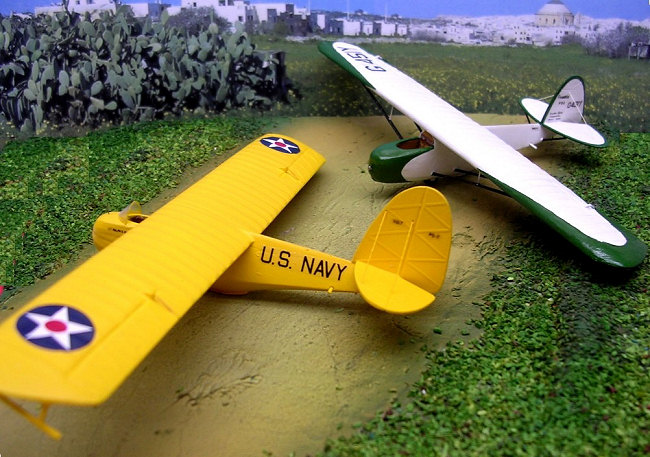
| KIT #: | ? |
| PRICE: | £14-15.00 |
| DECALS: | Two options |
| REVIEWER: | Carmel J. Attard |
| NOTES: | Resin |

| HISTORY |
In
1920, the brothers RF and Wallace H.Franklin designed and build a series of
gliders that came to be known as PS-2.They felt that this new glider had the
capacity to train pilots in both phases of instruction. The glider incorporated
a landing wheel in addition to the landing skid and was of an engineered design
for the stress of flight without multiple wire braces and controls. Frank Hawks
of Texas Company, an oil firm known as Texaco Company (Texaco) was attracted to
this 45ft. Span, hand built glider and had been scheduled to purchase the
immediate predecessor Franklin, a glider known as “9491”. Using this new glider
also known as “The Eaglet” and later “The Texaco Eaglet” Hawks was towed behind
a Texaco Waco 10 and flew cross-country from
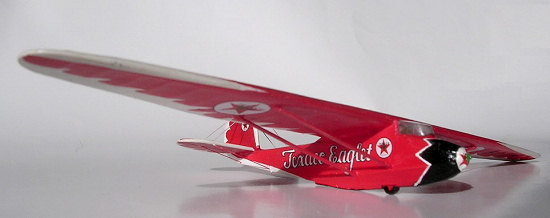 San Diego to New York and
along the flight the glider was shown to admiring crowd. After the flight Hawks
displayed the glider across the country before making a final show in December
1930 at Bolling Army Air Field in Washington DC before Texaco donated the craft
to the Smithsonian Institution.
San Diego to New York and
along the flight the glider was shown to admiring crowd. After the flight Hawks
displayed the glider across the country before making a final show in December
1930 at Bolling Army Air Field in Washington DC before Texaco donated the craft
to the Smithsonian Institution.
The Franklin PS-2 was the American glider of the early 20s. 57 PS-2 gliders were manufactured in Ypsilanti, Mich. between 1930 and 1934. The PS-2 became the most popular instruction glider in the country and the new 36-foot wingspan glider saw production of over 100 airframes. Franklin won three of the first famous National Soaring championships, which were all, held at Harris Hill near Elmira, New York. Stan Smith flew the glider serial No 112 registration No G451Y to first place in 1933 contest.
Six of the PS-2 produced went to the US Navy and these were assigned to Pensacola, Florida. Lt.Ralph S.Barnaby had mastered and introduced the use of gliders by the Navy on the flat scrubland of Florida. He finally won permission to use the craft to test prospective aviators before they progressed to powered aircraft. PS-2 was not given a military designation, which was rather unusual. These gliders were given an auto-tow to give limited flight experience, which was enough to see who could master the co-ordination of stick-and –rudder.
Glider G451Y was manufactured
in August 1930 and may be the oldest airworthy glider in the world. Joe Feather
of Jackson, Jack Wyman of Manchester and Chuck Franklin of Ann Arbor (son of RE
Franklin, the designer of PS2} finished restoring this glider the day before the
opening ceremonies of the 1995 International Vintage Sailplane Meet held at
Harris Hill. These guys barely got
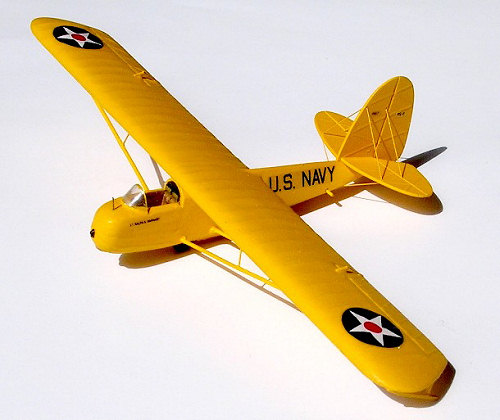 through the restoration
without fistcuffs, and somehow remained good friends. The glider won the best
restoration award at IVSM ’95 and the Frank Cross Award.
through the restoration
without fistcuffs, and somehow remained good friends. The glider won the best
restoration award at IVSM ’95 and the Frank Cross Award.
NACA received two PS-2 gliders, which were on loan from the Navy. These underwent initial service at Pensacola. Navy and NASA records indicate that the Bu Nos. were 9614 and 9615. The two were used from April 1936 to November 1938 before being stricken from the rolls of active aircraft
The last of six Navy PS-2 gliders Bu-9617 is now hanging on display at the National Museum of Naval Aviation in Pensacola, Florida. Two more PS-2 gliders survive in the collection of the National Soaring Museum in Elmira, New York while the famous G451Y still flies in private hands and may well be still the oldest flying glider in the world (2005).
PS-2 Glider
Span 36’
Wing Chord 5’
Wing area 180 Ft Sq
Empty Weight 220 lbs.
Gross Weight 400 lbs.
Max.glide ratio (claimed) 15/1
| THE KIT |
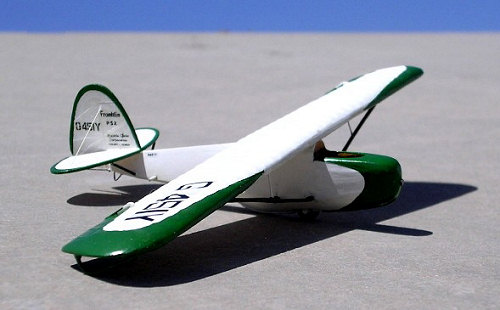 CMR has just released three
kits of the PS2 glider to a scale of 1/72. These come in two packs. The first
kit pack contains the Franklin PS-2 ‘Texaco Eaglet’ and is contained in Pack CMR
G25, consisting of the early wider wingspan PS-2. These are the markings for the
example exhibited at the Smithsonian National air and Space Museum. Two more
PS-2 gliders come with Pack CMR G26 both of which are of the slightly varied
type with a smaller wingspan and other noticeable differences from each other.
Two complete gliders of the type can be built complete with sets of decals for
both types. The decals represent a machine in USN markings, for which an
alternative number is also included. The other markings represent the IVSM 1995
award winner, which is the oldest, air worthy glider in the world.
CMR has just released three
kits of the PS2 glider to a scale of 1/72. These come in two packs. The first
kit pack contains the Franklin PS-2 ‘Texaco Eaglet’ and is contained in Pack CMR
G25, consisting of the early wider wingspan PS-2. These are the markings for the
example exhibited at the Smithsonian National air and Space Museum. Two more
PS-2 gliders come with Pack CMR G26 both of which are of the slightly varied
type with a smaller wingspan and other noticeable differences from each other.
Two complete gliders of the type can be built complete with sets of decals for
both types. The decals represent a machine in USN markings, for which an
alternative number is also included. The other markings represent the IVSM 1995
award winner, which is the oldest, air worthy glider in the world.
| CONSTRUCTION |
The kits are made of light tan
coloured resin and each consists of a fuselage piece cleverly made to
incorporate an integrally cast seat with straps. The cockpit floor also
indicates internal structural reinforcement when carefully examined. The
fuselage resin part also has the fuselage skid and single main wheel. There are
four x 40 mm long straight struts. These are of same length but those that come
in Pack G25 are of a wider chord and should not be mistook with those of the
shorter span PS-2 in case the 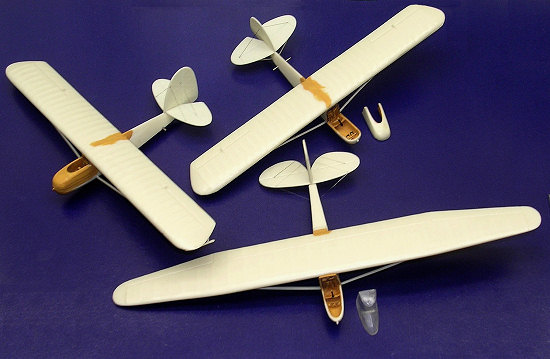 process
of assembly is carried out simultaneously as I have in fact done. The assembly
of the kit is straight forward, using super-glue to fix parts together. In spite
of the few items that one needs to join together for each complete kit it is
important to align wings to fuselage as well as properly fixing the tail plane
since any offsetting of parts or misalignment will easily show in the completed
model
process
of assembly is carried out simultaneously as I have in fact done. The assembly
of the kit is straight forward, using super-glue to fix parts together. In spite
of the few items that one needs to join together for each complete kit it is
important to align wings to fuselage as well as properly fixing the tail plane
since any offsetting of parts or misalignment will easily show in the completed
model
A 4 page of A4 size sheets comes with the kit and contain a fair amount of detailed photos, 12 in all, to enable build the kit with no need of other reference material. The history of the respective gliders is also given.
Pack G25
In Pack G25 there are also 4
view illustrations that contain all the colour details for the type including
the correct placement of the decal items. This contains a colourful bird wing
shape of decal in red that is slid on an otherwise white painted wings and with
the Texaco motif positions on wings and fuselage. Illustrations supplied are
helpful and easy to follow as you go along showing also the place where to add
the bracing wires to the rudder and tailplanes. A clear part, which appears to
be injection moulded, forms the canopy. This requires careful trimming of excess
plastic and is best removed by sanding it down till
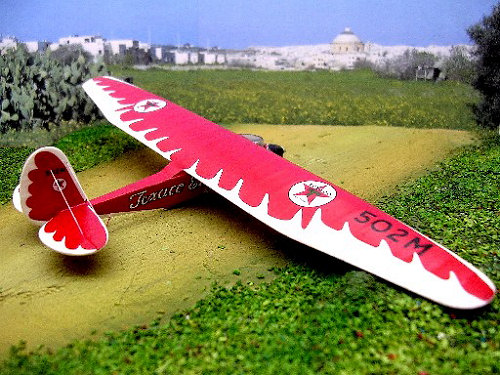 the
back end of the perspex is reached. This was an easy kit to build but again care
was needed for the alignment of the mainplanes and tail wings before these are
set hard with super glue. Very little putty was required at a place where the
underwings join the fuselage. The kit was given an overall white finish followed
by applying red paint to the fuselage area. The rest is for the full decal sheet
to make up the completed model.
the
back end of the perspex is reached. This was an easy kit to build but again care
was needed for the alignment of the mainplanes and tail wings before these are
set hard with super glue. Very little putty was required at a place where the
underwings join the fuselage. The kit was given an overall white finish followed
by applying red paint to the fuselage area. The rest is for the full decal sheet
to make up the completed model.
Pack GH 26
As mentioned earlier, the other pack GH26 consists of two glider kits. These look very much alike in several respects and the noticeable differences are that the Navy version has a windscreen while the civil one hasn’t. The wing tip skids also vary a little and the tail fin and rudder for the Navy glider has a larger surface area than the civil one. One should not overlook that there is also a variation in the position of the aileron link actuators. Those for the Navy PS-2 are closer to the fuselage than those of the other type. So careful study of the otherwise very easy to follow instruction sheet should be made when selecting the main wing of the type being assembled.
| COLORS & MARKINGS |
The Navy PS2 is finished in
overall yellow scheme while the civil one is white with bright green trim, and b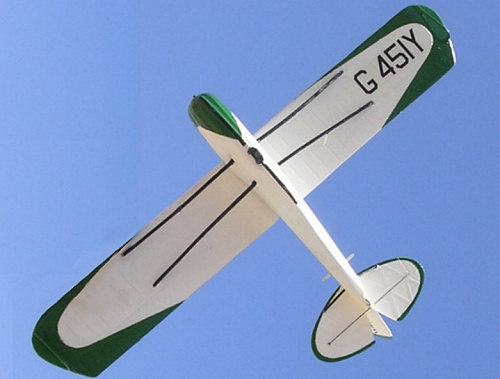 lack
registration letters. These kits contain few parts however the tiny parts are
very delicate to handle and care needs to be taken when joining the tiny cockpit
parts or the wing tip skids. The only extra work required on these kits were the
additions of thin bracing wire attached to the tail units of the entire three
models and I found best to use thin fishing line, or invisible thread. The
instruction sheet and three view drawings provided illustrate the location of
these very clearly.
lack
registration letters. These kits contain few parts however the tiny parts are
very delicate to handle and care needs to be taken when joining the tiny cockpit
parts or the wing tip skids. The only extra work required on these kits were the
additions of thin bracing wire attached to the tail units of the entire three
models and I found best to use thin fishing line, or invisible thread. The
instruction sheet and three view drawings provided illustrate the location of
these very clearly.
| CONCLUSIONS |
We have seen a series of glider releases by CMR. It is possible that few of us ever thought that the range of gliders has evolved in their own respects, away from the development of powered aircraft. Gliders also contributed towards the basic training and development of the early aviators apart from the element of sports in gliding. Indisputably the PS-2 was another of the famous gliders that filled a space in the history of flight and therefore more than worth to have it among our scale kit collections.
| REFERENCES |
History note by courtesy of Smithsonian Institution NASM.
June 2007
If you would like your product reviewed fairly and fairly quickly, please contact the editor or see other details in the Note to Contributors.